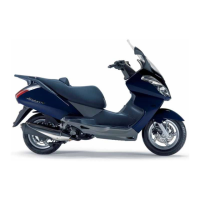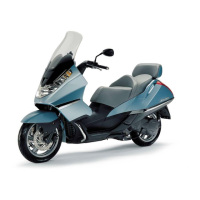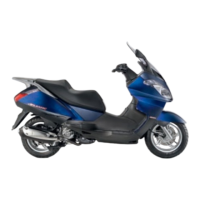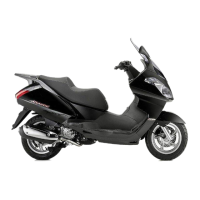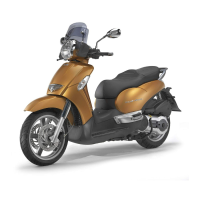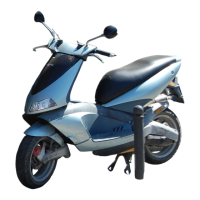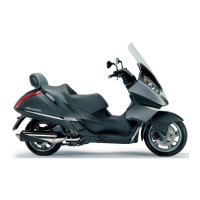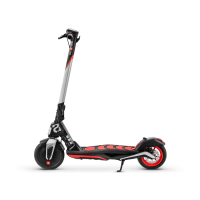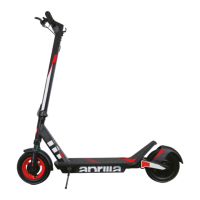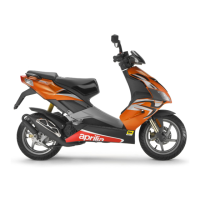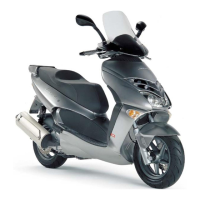
Do you have a question about the APRILIA ATLANTIC 500 sprint and is the answer not in the manual?
| Engine Type | Single-cylinder, 4-stroke |
|---|---|
| Displacement | 460 cc |
| Cooling System | Liquid-cooled |
| Fuel System | Electronic fuel injection |
| Front Suspension | Telescopic fork |
| Transmission | Automatic |
| Rear Suspension | Dual shock absorbers |
| Front Brake | Single disc |
Provides an introduction to the manual and its intended use for normal servicing.
Lists available reference manuals for the Aprilia vehicle.
Defines common abbreviations, symbols, and conventions used throughout the manual.
Explains manual structure, section indexing, and conventions used for clarity.
Details safety conventions, general rules, and basic safety precautions for operation.
Highlights hazardous materials and components, including fuel, lubricants, and coolant warnings.
Provides recommendations and guidelines for the initial running-in period of the vehicle.
Explains how to locate and identify the vehicle's serial and identification numbers.
Advises on using correct tools and genuine Aprilia spare parts for maintenance.
Lists detailed technical specifications and data for the vehicle.
Lists recommended lubricants, fluids, and their specifications for various vehicle parts.
Provides general torque settings for screws and bolts used in vehicle assembly.
Emphasizes the importance of following the routine maintenance schedule for optimal performance.
Presents a comprehensive table detailing maintenance tasks and intervals for vehicle components.
Identifies specific points on the vehicle that require lubrication and the type of lubricant.
Instructs to check fastening parts, especially safety-related components, for proper tightening.
Details specific torque settings and Loctite application for various vehicle fasteners.
Provides information on battery activation, maintenance, inspection, and warranty conditions.
Explains spark plug inspection, cleaning, gap setting, and replacement procedures.
Details the cleaning and replacement procedures for the air cleaner element.
Guides on checking and topping up the coolant level in the expansion reservoir.
Explains checking, topping up, and changing brake fluid, noting pad wear compensation.
Guides on checking front and rear brake pad wear and when to replace them.
Explains how to bleed air from the hydraulic braking system for optimal efficiency.
Provides instructions for checking, topping up engine oil, and changing the oil filter.
Guides on checking and topping up transmission oil and changing it.
Covers inspection of throttle operation and adjustment of engine idling speed.
Details steering bearing adjustment and front fork inspection.
Details checks for wheels, bearings, wobble, balancing, and tyre condition.
Instructs to tighten exhaust manifold nuts after specific mileage intervals.
Illustrates the fuel supply system diagram with key components identified.
Provides steps for removing and replacing the fuel filter.
Details the procedure for removing the fuel tank and fuel sensor.
Guides on removing the air box and air cleaner element.
Details carburetor removal, disassembly, assembly, and starter checks.
Provides instructions for adjusting the idling mixture using an exhaust gas tester.
Details the procedure for removing the exhaust silencer and the complete exhaust system.
Lists engine components that can be removed without taking the engine out of the frame.
Provides detailed steps and safety precautions for removing and installing the engine.
Illustrates the vehicle's bodywork components with numbered parts for identification.
Guides on removing the saddle, rear side panels, and luggage rack.
Details removal of the tail section, number plate holder, and central tunnel.
Guides on removing the air dam, legshield, and front cover.
Explains how to remove the windshield screen and rear-view mirrors.
Details removal of side fairings, front/rear mudguards, and helmet compartment.
Guides on removing handlebar covers, switches, and related components.
Details removal of splashguard and battery.
Explains removal of ECU, voltage regulator, and related electrical components.
Guides on removing the handlebar and the vehicle frame.
Covers front wheel diagram, removal, disassembly, inspection, and refitting.
Covers rear wheel diagram, removal, and related components.
Details brake system diagram, pad replacement, disc inspection, and removal.
Guides on headstock removal, bearing inspection, and front fork disassembly/assembly.
Covers shock absorber and linkages removal for the rear suspension.
Illustrates the layout of electrical components on the vehicle with numbered parts.
Details battery activation, maintenance, inspection, and warranty conditions.
Explains the ignition system and stand logic, including troubleshooting steps.
Covers charge system checks, voltage testing, alternator operation, and continuity.
Explains the starter circuit, including troubleshooting steps for the starter motor and relay.
Illustrates sensor circuits and details dashboard indicator tests for coolant and fuel levels.
Covers cooling fan operation tests and rear top box light switch tests.
Illustrates the lighting circuit and details bulb replacement procedures.
Covers troubleshooting for direction indicators and warning horn systems.
Guides on inspecting, identifying, and replacing fuses for the electrical system.
Explains how to adjust the headlight beam height and horizontal position.
Presents the complete wiring diagram for the vehicle's electrical system.
